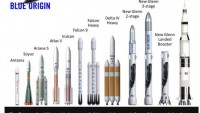Chinese, British Researchers Develop Self-healing Composite Materials
| Arthur Dominic Villasanta | | Sep 13, 2016 05:34 AM EDT |
(Photo : NASA) Self-healing composite materials might allow satelllites to fix themselves in space.
A research team from China and the United Kingdom has developed a method of allowing materials, commonly used in aircraft and satellites to self-heal cracks at temperatures well below freezing.
Self-healing composites are able to restore their properties automatically when needing repair.
Like Us on Facebook
The paper detailing this method is the first to show that self-healing materials can be manipulated to operate at very low temperatures (-60°C). It was published in Royal Society Open Science, a peer-reviewed open access scientific journal published by the Royal Society in the UK.
The team was led by the University of Birmingham in the UK and Harbin Institute of Technology in China.
The method can be applied to fiber-reinforced materials used in situations where repair or replacement is challenging such as offshore wind turbines, or even "impossible" such as aircraft and satellites during flight.
In favorable conditions, composites have yielded impressive healing efficiencies. Previous research efforts resulted in healing efficiencies above 100%, indicating the function or performance of the healed material can be better than that prior to damage.
Until this paper, however, healing was deemed insufficient in adverse conditions such as very low temperature.
Embedded in the composite are three-dimensional hollow vessels with the purpose of delivering and releasing the healing agents, and a porous conductive element to provide internal heating and to defrost where needed.
"Both of the elements are essential. Without the heating element, the liquid would be frozen at -60°C and the chemical reaction cannot be triggered. Without the vessels, the healing liquid cannot be automatically delivered to the cracks," said Yongjing Wang, PhD student at the University of Birmingham.
A healing efficiency of over 100% at temperatures of -60°C was obtained in a glass fiber-reinforced laminate, but the technique could be applied across a majority of self-healing composites.
Tests were run using a copper foam sheet or a carbon nanotube sheet as the conductive layer. The latter of the two was able to self-heal more effectively with an average recovery of 107.7% in fracture energy and 96.22% in peak load.
The healed fiber-reinforced composite, or host material, therefore has higher interlaminar properties -- that is the bonding quality between layers. The higher those properties, the less likely it is that cracks will occur in the future.
"Fiber-reinforced composites are popular due to their being both strong and lightweight, ideal for aircraft or satellites, but the risk of internal micro-cracks can cause catastrophic failure. These cracks are not only hard to detect, but also to repair, hence the need for the ability to self-heal," noted Wang.
The group will now look to eliminate the negative effects that heating elements have on peak load by using a more advanced heating layer.
Their ultimate goal, however, is to develop new healing mechanisms for more composites that can recover effectively regardless the size of faults in any condition.
TagsSelf-healing composites, University of Birmingham, Harbin Institute of Technology, composites, Yongjing Wang
©2015 Chinatopix All rights reserved. Do not reproduce without permission
EDITOR'S PICKS
-

Did the Trump administration just announce plans for a trade war with ‘hostile’ China and Russia?
-

US Senate passes Taiwan travel bill slammed by China
-

As Yan Sihong’s family grieves, here are other Chinese students who went missing abroad. Some have never been found
-

Beijing blasts Western critics who ‘smear China’ with the term sharp power
-

China Envoy Seeks to Defuse Tensions With U.S. as a Trade War Brews
-

Singapore's Deputy PM Provides Bitcoin Vote of Confidence Amid China's Blanket Bans
-

China warns investors over risks in overseas virtual currency trading
-

Chinese government most trustworthy: survey
-

Kashima Antlers On Course For Back-To-Back Titles
MOST POPULAR
LATEST NEWS
Zhou Yongkang: China's Former Security Chief Sentenced to Life in Prison

China's former Chief of the Ministry of Public Security, Zhou Yongkang, has been given a life sentence after he was found guilty of abusing his office, bribery and deliberately ... Full Article
TRENDING STORY

China Pork Prices Expected to Stabilize As The Supplies Recover

Elephone P9000 Smartphone is now on Sale on Amazon India

There's a Big Chance Cliffhangers Won't Still Be Resolved When Grey's Anatomy Season 13 Returns

Supreme Court Ruled on Samsung vs Apple Dispute for Patent Infringement

Microsoft Surface Pro 5 Rumors and Release Date: What is the Latest?














